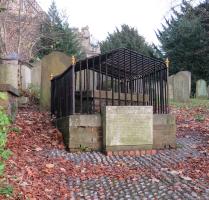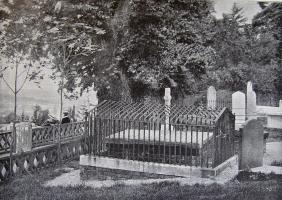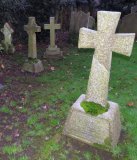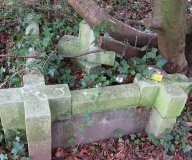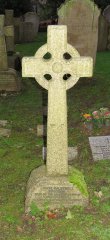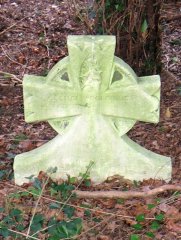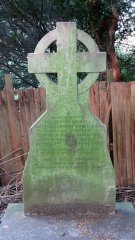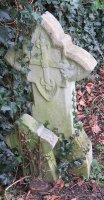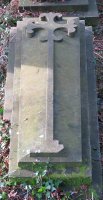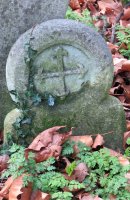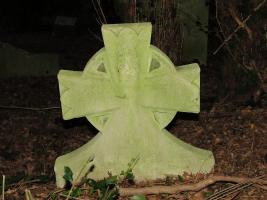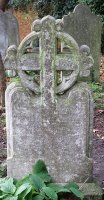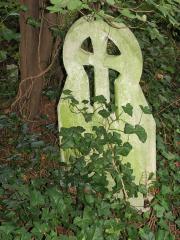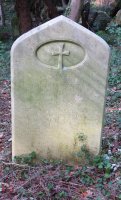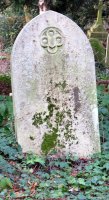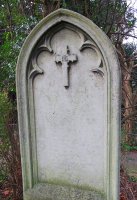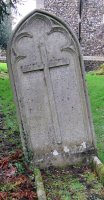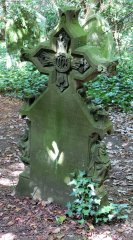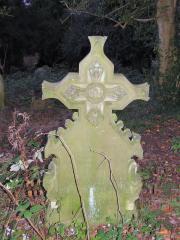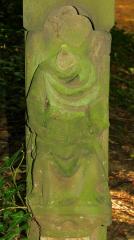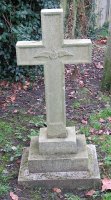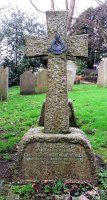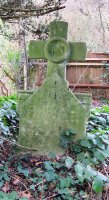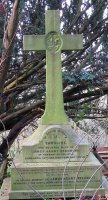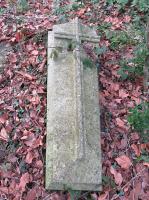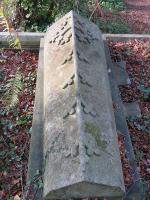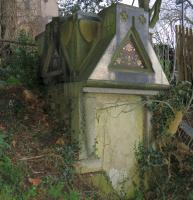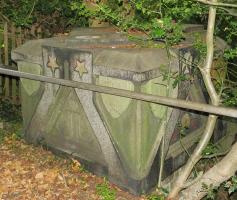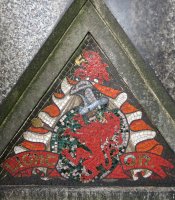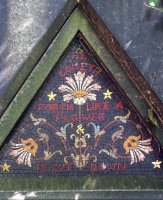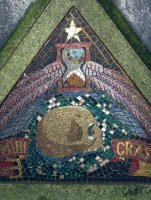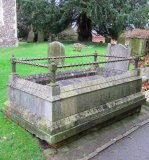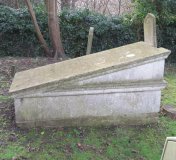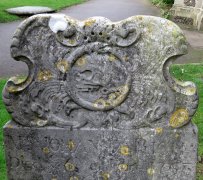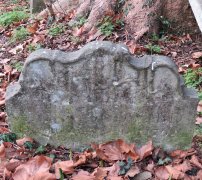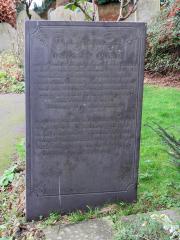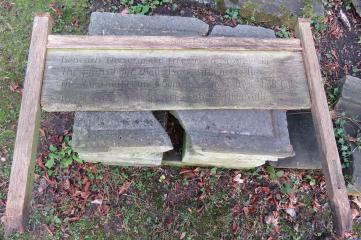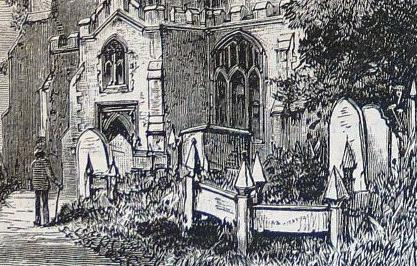Harrow on the Hill Churchyard - Byron's tomb, crosses and John Leighton
The churchyard of St Mary's Church, ancient parish church of Harrow on the Hill, is best known for its views out into the countryside, and the spot where the young Byron used to sit on top of a tomb to gaze forth and conceive his poetry. However, beyond the path, the churchyard spills down the slope, semi-overgrown with trees, most atmospheric, and contains a fair number of tombstones, notable for a good variety of cross designs, and one great tomb with mosaic work - the last resting place of the artist John Leighton FSA. Click any picture to enlarge, hover for caption.
The tomb which Byron used to sit on
The tomb, and late 19th Century view showing Byron's Elm.
We have to start with this - it is a low tomb-chest or altar tomb, brick sided, though once it would likely have borne panels commemorating those incarcerated within, and a thick stone slab on top, which is the place which Byron found so convenient to rest upon. We cannot read who was within that tomb, but years later, Byron himself recalled that it 'bore the name of Peachie or Peachey' in a letter to a publisher, and Historic England confirm it as John Peachey, d.1780. At some point in the later 19th Century it was covered with a metal grating, which remains, presumably to stop offending passers-by resting on the tomb as Byron did - a pointless act of officialdom perhaps depriving England of several latter-day poets, and ineffective in that it failed to preserve the epitaph under it; The stone is broken into shards, and I could see upon it the words ...[re]mains of ... Y Esq, ...Christopher,...East Indies... the date 178[9], and the broken name [J]ohn Bai... The initial name ending in 'Y Esq' would fit with the Peachey referred to by Byron, though the other names do not match those noted on the tomb by Historic England.
In front of the edifice, thus towards the view, a tablet records some lines written by Byron at the place, beginning "Spot of my youth! Whose hoary branches sigh // Swept by the breeze that fans the cloudless sky..." - the hoary branches refer to the tree overhanging the tomb at the time, later called "Byron's Elm". There is a step to climb on to better see the view, and a map to show those places which can be seen on a clear day.
Crosses in the churchyard
19th and earlier 20th Century tombstones frequently bear crosses, and many aesthetically pleasing varieties beyond the plain squared off cross were commonly used. Harrow on the Hill has a decent crop amongst a relatively small number of tombs, though a number of the larger ones have fallen or been knocked down by the health and safety barbarians.
Celtic cross (left) and two Canterbury crosses.
A most striking and convincing variation on the cross is the Celtic Cross, with a circle behind the cross, and typically a boss in the centre, as above left, sometimes including Celtic strapwork in the more ornate examples. A similar design without the long column, and splayed arms, is a Canterbury Cross, as in the little 1860 one to George Wooldridge above centre. The slightly simpler example, without splays and incorporated as the top of a heasdstone, above right, to Lt.-Col. Matthrew Poole, dates from 1885.
Cross Fleury monuments (click any picture to enlarge).
The Cross Fleury has at the end of each arm of the cross, a branching into three curved shapes, thus a fleur-de-lys. More often than not they are in raised relief, as in the examples above, the second being on a raised ledger. The far right one, from around 1900, is cut out.
Here are two curiosities of the Cross Fleury type in Harrow on the Hill churchyard. Firstly a Cross Fleury in relief upon a Canterbury Cross. And then one where the Fleur-de-Lys shapes are curled completely round to make little circles, in a rather Arts and Crafts style.
We have seen a couple of examples where elements of the cross are cut through the stone, and here is a nice example of a "keyhole cross", where the whole cross is delineated by virtue of the cut-outs.
Gothic headstones with crosses at Harrow.
Headstones with small crosses are common enough, and Harrow on the Hill has a number of examples. Above left, the panel to William Lancefield, d.1866, a minimalist Cross Fleury in an oval, well sized to the headstone, and next to it one with a quatrefoil. Next a more elaborate Gothic window style headstone, with the cross bearing the common abbreviation IHS for 'Jesus'. To the right, another Gothic piece with a tall cross, separating the two inscriptions, to Anna Rendall and her husband, the Revd. Frederic Rendall, Vicar of the Church and buried right next to it.
Moving on, we have a much more elaborate, though modestly scaled headstone to Major General George Ponsonby, d.1866, of the East India Company Army. It contains an embellished central cross within a cross-shaped frame, itself with extra carvings, as the upper part of a Gothic headstone with a niche underneath to either side containing a seated angel, much damaged. Excellent Victorian Gothic.
Two views of the cross to Maj-Gen George Ponsonby of the East India Company Army, and one of the angels.
This brings us on to crosses with a central embellishment - it is quite usual with military personnel, where the regimental insignia may be added, as in the crosses to William Cooper, d.1915, Bomber Command, and Capt George Withers, d.1947, as examples in Harrow from WW1 and WW2 respectively. An earlier, non-military example is the 1885 cross to Margaret Paterson (?), with a heavy circle to frame the IHS monogram, which we see again in the similarly-dated cross to Caroline Beaumont, within a small cartouche. You will have to click the pictures to enlarge to see these ones.
There are several examples of ledger stones (slightly raised table-like blocks which often have the inscription around the edges) and altar tombs or tomb chests (similar, but raised much higher and typically of stone built round an internal brick structure) bearing crosses in Harrow on the Hill churchyard; one example is further up this page, and here are two more: a simple one and a more complex decorative one. Such things are common from the 18th and 19th Centuries, and though the inscriptions on some are unreadable, I rather think our Harrow examples are all 19th Century.
There are other types of carved cross than found in Harrow on the Hill Churchyard, most notably the large class of angels and female figures with crosses, popular in cemeteries, and those carved with an abundance of foliage and flowers, which do not feature here. Examples of both can be found on the general page on cross monuments on this website.
Tomb of John Leighton FSA with mosaics
John Leighton FSA family tomb, with mosaics.
The artist John Leighton FSA, who used the pseudonym 'Luke Limner', has a large family tomb in Harrow Churchyard, designed by the artist originally for his wife, Emma Leighton (d.1867, the date on the tomb). He died in 1912, and there are several other names on the tomb. The solid granite edifice is next to the path leading up to the Church, and it is that side which bears the date and a shield to Emma Leighton, but the small mosaics face to the sides and down the slope. There are three triangular mosaics (shown above):
- A heraldic piece with red lion rampant and the emblem 'Light on', a play on Leighton's own name;
- A floral design with gold stars and the motto 'He cometh forth like a flower is cut down', from the Biblical book of Job.
- A skull under a winged hourglass with a star above, and the motto 'Hodie Mihi Cras Tibi', which translates cheerfully as 'Today me, tomorrow you'.
The mosaics (click to enlarge).
The mosaics are skilfully done using Italian Smalti and glass, and and close-set in Italian fashion; the choice of colours and design is well chosen for the scale. John Leighton was mostly a book illustrator and cover designer, and in 1853 published the excellent 'Suggestions in Design', with profuse illustrations by him, exemplifying the art of many different historical periods.
Also in the Churchyard
Massive tomb chests in Harrow on the Hill Churchyard.
We may mention that among a goodly number of other tomb chests or altar tombs, are one, now nameless, by the Church itself with nice ironwork on a walled sarcophagus, a heavy 18th Century casket with large coat of arms by the Byron piece, and a less usual tilted example - there is actually a second one of these lower down the Churchyard, but with the top slab lost.
18th Century headstones.
Among smaller pieces, we may note a few 18th Century headstones next to the Church, with carved tops. Here we have the headstone for Johanne Bigh, d.1753, with a skull, snake swallowing its tail - a pagan emblem if ever there was one - Acanthus leaves and scrolling. The second example is the headstone of poor Anne Woodward, d.1764 if I read it aright, almost sunken into the ground and perhaps not long to be visible in the future.
Here too is a single example of a slate panel, to Thomas Port, d.1838. It is not so easy to read, as the contrast is low, but for the reader willing to make the effort, the inscription tells with apparent ghoulish relish how he 'near this town, had both his legs severed from his body by the Railway Train. With the greatest fortitude he bore a second amputation by the surgeons, and died from loss of blood.' The tale was enough to move the writer to poetry: Bright rose the morn and vig'rous rose poor Port, // Gay on the Train, he used his wonted sport. // Ere noon arrived his mangled form they bore, // With pain distorted and overwhelmed with gore; // When evening came, to close the fatal day. // A mutilated corpse the sufferer lay'
Slate headstone to Thomas Port, d.1838.
The reason to mention this piece is because it shows how perfectly the slate survives the weather, so much better than stone headstones of more recent date in the Churchyard. Slate headstones were not popular in this part of the country, and this one is signed by the mason Brunt of Burton on Trent.
Isaac Greentree, wooden headboard.
At the other extreme, we have a single example of a wooden headboard (click to enlarge and read), a renewal from an old one decaying away, uprooted and replanted round the side of the Church, to Isaac Greentree. Undated, it bears a more sympathetic verse: 'Beneath these green trees rising to the skies // the planter of them, Isaac Greentree lies.// The day shall come when the tree trees shall fall // and Isaac Greentree rise above them all.'
Old illustrations of the Church show that there used to be many more such headboards, including along the path between the Lych gate and the entrance porch.
Wooden headboards by Harrow Church.
